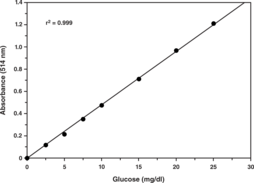Cayman
Showing 22051–22200 of 45550 results
-
Gliclazide is a sulfonylurea and an inhibitor of pancreatic β-cell ATP-sensitive potassium (KATP) channels (IC50 = 184 nM for murine β-cells).{47058,34125} It is selective for pancreatic β-cell over cardiac and arterial smooth muscle cell KATP channels (IC50s = 19.5 and 37.9 μM, respectively).{47058} Gliclazide (5 μM) increases insulin-induced glucose uptake and glucose transporter 4 (GLUT4) translocation to the plasma membrane in a differentiated 3T3L1 adipocyte model of insulin resistance induced by hydrogen peroxide.{47059} Gliclazide (5 and 10 μg/ml) reduces LDL oxidation by human aortic smooth muscle cells (HASMCs), decreasing TBARS content and 8-isoprostane levels.{8975} It also decreases oxidized LDL-induced HASMC proliferation and monocyte adhesion when used at concentrations ranging from 1 to 10 μg/ml. Gliclazide (5mg/kg) reduces serum glucose levels and increases glucose uptake by isolated rat hindquarters in a model of diabetes induced by streptozotocin (STZ; Item No. 13104).{47060}
Brand:CaymanSKU:25503 - 1 gAvailable on backorder
Gliclazide is a sulfonylurea and an inhibitor of pancreatic β-cell ATP-sensitive potassium (KATP) channels (IC50 = 184 nM for murine β-cells).{47058,34125} It is selective for pancreatic β-cell over cardiac and arterial smooth muscle cell KATP channels (IC50s = 19.5 and 37.9 μM, respectively).{47058} Gliclazide (5 μM) increases insulin-induced glucose uptake and glucose transporter 4 (GLUT4) translocation to the plasma membrane in a differentiated 3T3L1 adipocyte model of insulin resistance induced by hydrogen peroxide.{47059} Gliclazide (5 and 10 μg/ml) reduces LDL oxidation by human aortic smooth muscle cells (HASMCs), decreasing TBARS content and 8-isoprostane levels.{8975} It also decreases oxidized LDL-induced HASMC proliferation and monocyte adhesion when used at concentrations ranging from 1 to 10 μg/ml. Gliclazide (5mg/kg) reduces serum glucose levels and increases glucose uptake by isolated rat hindquarters in a model of diabetes induced by streptozotocin (STZ; Item No. 13104).{47060}
Brand:CaymanSKU:25503 - 10 gAvailable on backorder
Gliclazide is a sulfonylurea and an inhibitor of pancreatic β-cell ATP-sensitive potassium (KATP) channels (IC50 = 184 nM for murine β-cells).{47058,34125} It is selective for pancreatic β-cell over cardiac and arterial smooth muscle cell KATP channels (IC50s = 19.5 and 37.9 μM, respectively).{47058} Gliclazide (5 μM) increases insulin-induced glucose uptake and glucose transporter 4 (GLUT4) translocation to the plasma membrane in a differentiated 3T3L1 adipocyte model of insulin resistance induced by hydrogen peroxide.{47059} Gliclazide (5 and 10 μg/ml) reduces LDL oxidation by human aortic smooth muscle cells (HASMCs), decreasing TBARS content and 8-isoprostane levels.{8975} It also decreases oxidized LDL-induced HASMC proliferation and monocyte adhesion when used at concentrations ranging from 1 to 10 μg/ml. Gliclazide (5mg/kg) reduces serum glucose levels and increases glucose uptake by isolated rat hindquarters in a model of diabetes induced by streptozotocin (STZ; Item No. 13104).{47060}
Brand:CaymanSKU:25503 - 25 gAvailable on backorder
Gliclazide is a sulfonylurea and an inhibitor of pancreatic β-cell ATP-sensitive potassium (KATP) channels (IC50 = 184 nM for murine β-cells).{47058,34125} It is selective for pancreatic β-cell over cardiac and arterial smooth muscle cell KATP channels (IC50s = 19.5 and 37.9 μM, respectively).{47058} Gliclazide (5 μM) increases insulin-induced glucose uptake and glucose transporter 4 (GLUT4) translocation to the plasma membrane in a differentiated 3T3L1 adipocyte model of insulin resistance induced by hydrogen peroxide.{47059} Gliclazide (5 and 10 μg/ml) reduces LDL oxidation by human aortic smooth muscle cells (HASMCs), decreasing TBARS content and 8-isoprostane levels.{8975} It also decreases oxidized LDL-induced HASMC proliferation and monocyte adhesion when used at concentrations ranging from 1 to 10 μg/ml. Gliclazide (5mg/kg) reduces serum glucose levels and increases glucose uptake by isolated rat hindquarters in a model of diabetes induced by streptozotocin (STZ; Item No. 13104).{47060}
Brand:CaymanSKU:25503 - 5 gAvailable on backorder
Glimepiride is a long-acting sulfonylurea that inhibits ATP-sensitive potassium (KATP) channels in pancreatic β-cells (IC50 = 3 nM), which leads to the release of insulin.{25521} At 20 μM, glimepiride has been shown to increase the activity of intracellular insulin receptors and to prevent insulin receptor downregulation during chronic insulin stimulation through a mechanism involving protein kinase C activation.{25523} It has been reported to be less effective at inhibiting nonpancreatic KATP channels, and therefore contributes fewer cardiac actions, compared to earlier generations of sulfonylurea anti-type 2 diabetes treatments.{25522}
Brand:CaymanSKU:12090 - 1 gAvailable on backorder
Glimepiride is a long-acting sulfonylurea that inhibits ATP-sensitive potassium (KATP) channels in pancreatic β-cells (IC50 = 3 nM), which leads to the release of insulin.{25521} At 20 μM, glimepiride has been shown to increase the activity of intracellular insulin receptors and to prevent insulin receptor downregulation during chronic insulin stimulation through a mechanism involving protein kinase C activation.{25523} It has been reported to be less effective at inhibiting nonpancreatic KATP channels, and therefore contributes fewer cardiac actions, compared to earlier generations of sulfonylurea anti-type 2 diabetes treatments.{25522}
Brand:CaymanSKU:12090 - 5 gAvailable on backorder
Glimepiride is a long-acting sulfonylurea that inhibits ATP-sensitive potassium (KATP) channels in pancreatic β-cells (IC50 = 3 nM), which leads to the release of insulin.{25521} At 20 μM, glimepiride has been shown to increase the activity of intracellular insulin receptors and to prevent insulin receptor downregulation during chronic insulin stimulation through a mechanism involving protein kinase C activation.{25523} It has been reported to be less effective at inhibiting nonpancreatic KATP channels, and therefore contributes fewer cardiac actions, compared to earlier generations of sulfonylurea anti-type 2 diabetes treatments.{25522}
Brand:CaymanSKU:12090 - 500 mgAvailable on backorder
Gliorosein is a fungal metabolite produced by Gliocladium.{38996} It is an isomer of rubrogliocladin hydroquinone. Gliorosein has antibiotic activity against B. allii, B. subtilis, and E. coli.
Brand:CaymanSKU:24921 - 1 mgAvailable on backorder
Gliorosein is a fungal metabolite produced by Gliocladium.{38996} It is an isomer of rubrogliocladin hydroquinone. Gliorosein has antibiotic activity against B. allii, B. subtilis, and E. coli.
Brand:CaymanSKU:24921 - 5 mgAvailable on backorder
Gliotoxin is an immunosuppressive mycotoxin produced by pathogenic strains of Aspergillus and other fungi with diverse biological activities.{21692,21695,21694,21690,21693,21689,43859,21714} It inhibits 20S proteasomal chymotrypsin activity (IC50 = 10 μM), blocking the degradation of IκBα and preventing the activation of NF-κB.{21695,21694} Gliotoxin induces apoptosis in monocytes and dendritic cells and reduces phagocytosis by neutrophils.{21690,21693} It suppresses viral infection by Nipah and Hendra virus in HEK293T cells (IC50s = 149 and 579 nM, respectively).{21689} Under reducing conditions, gliotoxin inhibits leukotriene A4 hydrolase (LTA4H; Item No. 10007817) epoxide hydrolase activity, but not aminopeptidase activity, and leukotriene B4 (LTB4; Item No. 20110) synthesis in neutrophils and monocytes.{43859} In vivo, gliotoxin (5 mg/kg) reduces LTB4 plasma levels and blocks peritoneal neutrophil infiltration in a mouse model of peritonitis induced by zymosan A (Item No. 21175). It also inhibits geranylgeranyltransferase I and farnesyltransferase (IC50s = 17 and 80 μM, respectively).{21714}
Brand:CaymanSKU:11433 - 1 mgAvailable on backorder
Gliotoxin is an immunosuppressive mycotoxin produced by pathogenic strains of Aspergillus and other fungi with diverse biological activities.{21692,21695,21694,21690,21693,21689,43859,21714} It inhibits 20S proteasomal chymotrypsin activity (IC50 = 10 μM), blocking the degradation of IκBα and preventing the activation of NF-κB.{21695,21694} Gliotoxin induces apoptosis in monocytes and dendritic cells and reduces phagocytosis by neutrophils.{21690,21693} It suppresses viral infection by Nipah and Hendra virus in HEK293T cells (IC50s = 149 and 579 nM, respectively).{21689} Under reducing conditions, gliotoxin inhibits leukotriene A4 hydrolase (LTA4H; Item No. 10007817) epoxide hydrolase activity, but not aminopeptidase activity, and leukotriene B4 (LTB4; Item No. 20110) synthesis in neutrophils and monocytes.{43859} In vivo, gliotoxin (5 mg/kg) reduces LTB4 plasma levels and blocks peritoneal neutrophil infiltration in a mouse model of peritonitis induced by zymosan A (Item No. 21175). It also inhibits geranylgeranyltransferase I and farnesyltransferase (IC50s = 17 and 80 μM, respectively).{21714}
Brand:CaymanSKU:11433 - 10 mgAvailable on backorder
Gliotoxin is an immunosuppressive mycotoxin produced by pathogenic strains of Aspergillus and other fungi with diverse biological activities.{21692,21695,21694,21690,21693,21689,43859,21714} It inhibits 20S proteasomal chymotrypsin activity (IC50 = 10 μM), blocking the degradation of IκBα and preventing the activation of NF-κB.{21695,21694} Gliotoxin induces apoptosis in monocytes and dendritic cells and reduces phagocytosis by neutrophils.{21690,21693} It suppresses viral infection by Nipah and Hendra virus in HEK293T cells (IC50s = 149 and 579 nM, respectively).{21689} Under reducing conditions, gliotoxin inhibits leukotriene A4 hydrolase (LTA4H; Item No. 10007817) epoxide hydrolase activity, but not aminopeptidase activity, and leukotriene B4 (LTB4; Item No. 20110) synthesis in neutrophils and monocytes.{43859} In vivo, gliotoxin (5 mg/kg) reduces LTB4 plasma levels and blocks peritoneal neutrophil infiltration in a mouse model of peritonitis induced by zymosan A (Item No. 21175). It also inhibits geranylgeranyltransferase I and farnesyltransferase (IC50s = 17 and 80 μM, respectively).{21714}
Brand:CaymanSKU:11433 - 5 mgAvailable on backorder
Gliovirin is a fungal metabolite that has been found in T. harzianum and has fungicidal, antimicrobial and anti-inflammatory activities.{46408} It is active against the plant pathogenic fungus P. ultimum (MIC = 60 ng/ml) and the parasite T. brucei brucei (IC50 = 90 ng/ml), but has no effect on the plant pathogenic fungi R. solani, P. omnivorum, T. basicola, R. arrhizus, and V. dahliae or the bacteria B. thuringiensis, P. fluorescens, and X. malvacearum when used at concentrations up to 1,000 ng/ml.{46409,46410} Gliovirin decreases phorbol 12-myristate 13-acetate (TPA)- and ionomycin-induced increased expression of COX-2 (IC50 = 1 µM) and protein levels of IL-2 in Jurkat cells (IC50 = 5.2 µM).{46408}
Brand:CaymanSKU:28583 - 1 mgAvailable on backorder
Glipizide is a hypoglycemic agent.{46791} It inhibits ATP-sensitive potassium (KATP) channels in primary mouse pancreatic β cells (IC50 = 6.4 nM). Glipizide induces insulin release from isolated rat pancreatic tissue with an EC50 value of 40 nM.{46792} Dietary administration of glipizide (5 mg/kg per day for 10 days) increases the number of insulin receptors on isolated and purified mouse liver plasma membranes.{46793} It reduces plasma glucose and triglyceride, but not total cholesterol, levels and increases plasma insulin levels in a rat model of diabetes induced by a high-fat diet and streptozotocin (STZ; Item No. 13104) when administered orally at a dose of 5 mg/kg.{46794} Formulations containing glipizide have been used in the treatment of type 2 diabetes.
Brand:CaymanSKU:11579 - 1 gAvailable on backorder
Glipizide is a hypoglycemic agent.{46791} It inhibits ATP-sensitive potassium (KATP) channels in primary mouse pancreatic β cells (IC50 = 6.4 nM). Glipizide induces insulin release from isolated rat pancreatic tissue with an EC50 value of 40 nM.{46792} Dietary administration of glipizide (5 mg/kg per day for 10 days) increases the number of insulin receptors on isolated and purified mouse liver plasma membranes.{46793} It reduces plasma glucose and triglyceride, but not total cholesterol, levels and increases plasma insulin levels in a rat model of diabetes induced by a high-fat diet and streptozotocin (STZ; Item No. 13104) when administered orally at a dose of 5 mg/kg.{46794} Formulations containing glipizide have been used in the treatment of type 2 diabetes.
Brand:CaymanSKU:11579 - 5 gAvailable on backorder
Glipizide-d11 is intended for use as an internal standard for the quantification of glipizide (Item No. 11579) by GC- or LC-MS. Glipizide is a hypoglycemic agent.{46791} It inhibits ATP-sensitive potassium (KATP) channels in primary mouse pancreatic β cells (IC50 = 6.4 nM). Glipizide induces insulin release from isolated rat pancreatic tissue with an EC50 value of 40 nM.{46792} Dietary administration of glipizide (5 mg/kg per day for 10 days) increases the number of insulin receptors on isolated and purified mouse liver plasma membranes.{46793} It reduces plasma glucose and triglyceride, but not total cholesterol, levels and increases plasma insulin levels in a rat model of diabetes induced by a high-fat diet and streptozotocin (STZ; Item No. 13104) when administered orally at a dose of 5 mg/kg.{46794} Formulations containing glipizide have been used in the treatment of type 2 diabetes.
Brand:CaymanSKU:30074 - 1 mgAvailable on backorder
Glipizide-d11 is intended for use as an internal standard for the quantification of glipizide (Item No. 11579) by GC- or LC-MS. Glipizide is a hypoglycemic agent.{46791} It inhibits ATP-sensitive potassium (KATP) channels in primary mouse pancreatic β cells (IC50 = 6.4 nM). Glipizide induces insulin release from isolated rat pancreatic tissue with an EC50 value of 40 nM.{46792} Dietary administration of glipizide (5 mg/kg per day for 10 days) increases the number of insulin receptors on isolated and purified mouse liver plasma membranes.{46793} It reduces plasma glucose and triglyceride, but not total cholesterol, levels and increases plasma insulin levels in a rat model of diabetes induced by a high-fat diet and streptozotocin (STZ; Item No. 13104) when administered orally at a dose of 5 mg/kg.{46794} Formulations containing glipizide have been used in the treatment of type 2 diabetes.
Brand:CaymanSKU:30074 - 500 µgAvailable on backorder
Gliquidone is a second generation sulfonylurea that selectively inhibits ATP-sensitive potassium channel currents (IKATP) in pancreatic β-cells (IC50s = 0.45, 119.1, and 149.7 µM for HIT-T15 cells, cardiomyocytes, and vascular smooth muscle cells, respectively).{49421} It is also a peroxisome proliferator-activated receptor γ (PPARγ) agonist (EC50 = 10 μM in a transactivation assay).{49422} Gliquidone (0.2 nmol/g) decreases plasma levels of D-glucose and stimulates insulin release in anesthetized rats.{49423} It decreases blood glucose levels, serum alkaline phosphatase (ALP), aspartate aminotransferase (AST), and alanine aminotransferase (ALT) activities, and hepatic lipid peroxidation and increases hepatic glutathione (GSH) levels in a rat model of diabetes induced by streptozotocin (STZ; Item No. 13104) when administered at a dose of 10 mg/kg.{49424}
Brand:CaymanSKU:29596 - 1 gAvailable on backorder
Gliquidone is a second generation sulfonylurea that selectively inhibits ATP-sensitive potassium channel currents (IKATP) in pancreatic β-cells (IC50s = 0.45, 119.1, and 149.7 µM for HIT-T15 cells, cardiomyocytes, and vascular smooth muscle cells, respectively).{49421} It is also a peroxisome proliferator-activated receptor γ (PPARγ) agonist (EC50 = 10 μM in a transactivation assay).{49422} Gliquidone (0.2 nmol/g) decreases plasma levels of D-glucose and stimulates insulin release in anesthetized rats.{49423} It decreases blood glucose levels, serum alkaline phosphatase (ALP), aspartate aminotransferase (AST), and alanine aminotransferase (ALT) activities, and hepatic lipid peroxidation and increases hepatic glutathione (GSH) levels in a rat model of diabetes induced by streptozotocin (STZ; Item No. 13104) when administered at a dose of 10 mg/kg.{49424}
Brand:CaymanSKU:29596 - 10 gAvailable on backorder
Gliquidone is a second generation sulfonylurea that selectively inhibits ATP-sensitive potassium channel currents (IKATP) in pancreatic β-cells (IC50s = 0.45, 119.1, and 149.7 µM for HIT-T15 cells, cardiomyocytes, and vascular smooth muscle cells, respectively).{49421} It is also a peroxisome proliferator-activated receptor γ (PPARγ) agonist (EC50 = 10 μM in a transactivation assay).{49422} Gliquidone (0.2 nmol/g) decreases plasma levels of D-glucose and stimulates insulin release in anesthetized rats.{49423} It decreases blood glucose levels, serum alkaline phosphatase (ALP), aspartate aminotransferase (AST), and alanine aminotransferase (ALT) activities, and hepatic lipid peroxidation and increases hepatic glutathione (GSH) levels in a rat model of diabetes induced by streptozotocin (STZ; Item No. 13104) when administered at a dose of 10 mg/kg.{49424}
Brand:CaymanSKU:29596 - 5 gAvailable on backorder
Gliquidone is a second generation sulfonylurea that selectively inhibits ATP-sensitive potassium channel currents (IKATP) in pancreatic β-cells (IC50s = 0.45, 119.1, and 149.7 µM for HIT-T15 cells, cardiomyocytes, and vascular smooth muscle cells, respectively).{49421} It is also a peroxisome proliferator-activated receptor γ (PPARγ) agonist (EC50 = 10 μM in a transactivation assay).{49422} Gliquidone (0.2 nmol/g) decreases plasma levels of D-glucose and stimulates insulin release in anesthetized rats.{49423} It decreases blood glucose levels, serum alkaline phosphatase (ALP), aspartate aminotransferase (AST), and alanine aminotransferase (ALT) activities, and hepatic lipid peroxidation and increases hepatic glutathione (GSH) levels in a rat model of diabetes induced by streptozotocin (STZ; Item No. 13104) when administered at a dose of 10 mg/kg.{49424}
Brand:CaymanSKU:29596 - 500 mgAvailable on backorder
Globosuxanthone A is a fungal metabolite originally isolated from C. globosum.{48211} It is cytotoxic to various human solid tumor cell lines, including MCF-7, PC3, LNCap, and DU145 cells (IC50s = 1.3, 0.65, 1.5, and 1.2 µM, respectively). It induces accumulation of cells in the G2/M and S phases of the cell cycle in NCI-H460 and PC3M cells. Globosuxanthone A is also active against C. albicans but not S. aureus, E. coli, or M. hiemalis.{48212}
Brand:CaymanSKU:27486 - 1 mgAvailable on backorder
Globosuxanthone A is a fungal metabolite originally isolated from C. globosum.{48211} It is cytotoxic to various human solid tumor cell lines, including MCF-7, PC3, LNCap, and DU145 cells (IC50s = 1.3, 0.65, 1.5, and 1.2 µM, respectively). It induces accumulation of cells in the G2/M and S phases of the cell cycle in NCI-H460 and PC3M cells. Globosuxanthone A is also active against C. albicans but not S. aureus, E. coli, or M. hiemalis.{48212}
Brand:CaymanSKU:27486 - 5 mgAvailable on backorder
Globosuxanthone A is a fungal metabolite originally isolated from C. globosum.{48211} It is cytotoxic to various human solid tumor cell lines, including MCF-7, PC3, LNCap, and DU145 cells (IC50s = 1.3, 0.65, 1.5, and 1.2 µM, respectively). It induces accumulation of cells in the G2/M and S phases of the cell cycle in NCI-H460 and PC3M cells. Globosuxanthone A is also active against C. albicans but not S. aureus, E. coli, or M. hiemalis.{48212}
Brand:CaymanSKU:27486 - 500 µgAvailable on backorder
Globotetraosylceramides (Item Nos. 24881) are bioactive neutral glycosphingolipids. They are the major glycolipids in human erythrocytes.{43016} They act as receptors for the Shiga toxins Stx1, Stx2, and Stx2e, the cytotoxic protein pierisin-1, and parvovirus B19.{43017,43018,43019} Globotetraosylceramides increase the expression of proteins responsible for enamel deposition, including ameloblastin, amelogenin, and enamelin, in dental epithelial cells and activate the ERK and p38 MAPK signaling pathways.{43020} Levels of globotetraosylceramides are elevated in fibroblasts from patients with salt and pepper syndrome, a neurocutaneous condition characterized by intellectual disability and hyper- and hypo-pigmented skin.{43021} Globotetraosylceramide Polyclonal Antibody can be used for ELISA and TLC immunoblotting. [Matreya, LLC. Catalog No. 1960]
Brand:CaymanSKU:28641 - 50 µlAvailable on backorder
Immunogen: Purified globotetraosylceramide and complete Freund’s adjuvant • Host: Rabbit • Applications: ELISA and TLC immunoblotting
Brand:CaymanSKU:28641- 50 µlAvailable on backorder
Immunogen: Purified globotetraosylceramide and complete Freund’s adjuvant • Host: Rabbit • Applications: ELISA and TLC immunoblotting
Brand:CaymanSKU:28641- 50 µlGlobotetraosylceramides are bioactive neutral glycosphingolipids. They are the major glycolipids in human erythrocytes.{43016} They act as receptors for the Shiga toxins Stx1, Stx2, and Stx2e, the cytotoxic protein pierisin-1, and parvovirus B19.{43017,43018,43019} Globotetraosylceramides increase the expression of proteins responsible for enamel deposition, including ameloblastin, amelogenin, and enamelin, in dental epithelial cells and activate the ERK and p38 MAPK signaling pathways.{43020} Levels of globotetraosylceramides are elevated in fibroblasts from patients with salt and pepper syndrome, a neurocutaneous condition characterized by intellectual disability and hyper- and hypo-pigmented skin.{43021} Globotetraosylceramides (porcine RBC) contains a mixture of globotetraosylceramides with variable fatty acyl chain lengths isolated from porcine red blood cells. [Matreya, LLC. Catalog No. 1068]
Brand:CaymanSKU:24881 - 5 mgAvailable on backorder
Globotriaosycleramides are glycosphingolipids found in mammalian cell membranes that are synthesized from lactosylceramides (Item No. 16983).{38975} They act as receptors for Shiga and Shiga-like toxins in vitro and in vivo.{38976} Globotriaosylceramides accumulate in endothelial cells, pericytes, vascular smooth muscle cells, renal epithelial cells, dorsal ganglia neuronal cells, and myocardial cells in patients with Fabry disease, a lysosomal storage disorder characterized by a deficiency in the enzyme α-galactosidase A.{38977} Globotriaosylceramides act as natural resistance factors to HIV infection, interacting with HIV gp120 to prevent its interaction with chemokine co-receptors and subsequent fusion of HIV to host cell membranes.{38975} This product contains a mixture of hydroxy and non-hydroxy fatty acid-containing globotriaosylceramides isolated from porcine red blood cells (RBCs). [Matreya, LLC. Catalog No. 1067]
Brand:CaymanSKU:24870 - 1 mgAvailable on backorder
Globotriaosycleramides are glycosphingolipids found in mammalian cell membranes that are synthesized from lactosylceramides (Item No. 16983).{38975} They act as receptors for Shiga and Shiga-like toxins in vitro and in vivo.{38976} Globotriaosylceramides accumulate in endothelial cells, pericytes, vascular smooth muscle cells, renal epithelial cells, dorsal ganglia neuronal cells, and myocardial cells in patients with Fabry disease, a lysosomal storage disorder characterized by a deficiency in the enzyme α-galactosidase A.{38977} Globotriaosylceramides act as natural resistance factors to HIV infection, interacting with HIV gp120 to prevent its interaction with chemokine co-receptors and subsequent fusion of HIV to host cell membranes.{38975} This product contains a mixture of hydroxy and non-hydroxy fatty acid-containing globotriaosylceramides isolated from porcine red blood cells (RBCs). [Matreya, LLC. Catalog No. 1067]
Brand:CaymanSKU:24870 - 10 mgAvailable on backorder
Brand:CaymanSKU:600572 - 125 µlAvailable on backorder
Most histone lysine methyltransferases contain a conserved domain (SET) that utilizes S-adenosyl-L-methionine (SAM or AdoMet) as a co-factor to catalyze the methylation of the epsilon amino group of lysine. G9a-like protein (GLP) is a SET domain-containing methyltransferase that specifically mono- and di-methylates histone H3 at lysine 9 (H3K9). GLP and G9a function as major euchromatic H3K9me1 and H3K9me2 histone methyltransferases and also have been found to methylate several nonhistone substrates, including p53(K372). This fluorescence polarization assay is based upon a proprietary small molecule fluorescent probe* that binds to the SAM binding pocket in GLP. Binding of the small molecule probe to GLP induces an increase in fluorescence polarization. Binding of the probe can be competed with the endogenous cofactor SAM or by the inhibitor sinefungin, but is unaffected by the histone H3 peptide substrate. The GLP SAM-Screener™ Assay is robust (Z’ >0.5) and exhibits a greater than 100 mP shift over a range of 0-250 nM GLP. The assay is suitable for high-throughput screening in the provided 384-well plate or can be scaled to higher density plate formats (e.g., 1,536-well) if desired. *United States Patent 9,120,820
Brand:CaymanSKU:600570 - 1920 wellsAvailable on backorder
Most histone lysine methyltransferases contain a conserved domain (SET) that utilizes S-adenosyl-L-methionine (SAM or AdoMet) as a co-factor to catalyze the methylation of the epsilon amino group of lysine. G9a-like protein (GLP) is a SET domain-containing methyltransferase that specifically mono- and di-methylates histone H3 at lysine 9 (H3K9). GLP and G9a function as major euchromatic H3K9me1 and H3K9me2 histone methyltransferases and also have been found to methylate several nonhistone substrates, including p53(K372). This fluorescence polarization assay is based upon a proprietary small molecule fluorescent probe* that binds to the SAM binding pocket in GLP. Binding of the small molecule probe to GLP induces an increase in fluorescence polarization. Binding of the probe can be competed with the endogenous cofactor SAM or by the inhibitor sinefungin, but is unaffected by the histone H3 peptide substrate. The GLP SAM-Screener™ Assay is robust (Z’ >0.5) and exhibits a greater than 100 mP shift over a range of 0-250 nM GLP. The assay is suitable for high-throughput screening in the provided 384-well plate or can be scaled to higher density plate formats (e.g., 1,536-well) if desired. *United States Patent 9,120,820
Brand:CaymanSKU:600570 - 384 wellsAvailable on backorder
GLP-1R agonist DMB is an agonist of glucagon-like peptide 1 receptor (GLP-1R; KB = 26.3 nM for the recombinant human receptor).{46660} It inhibits forskolin-induced cAMP accumulation in BHK cells expressing the recombinant human receptor with an EC50 value of 101 nM.{46661} GLP-1R (100 and 1,000 nM) increases insulin levels induced by D-(+)-glucose (Item No. 23733) in pancreatic islets isolated from wild-type, but not Glp1r knockout, mice. It reduces fasting plasma glucose levels in mice when administered at a dose of 5 µmol/kg.{46662}
Brand:CaymanSKU:29678 - 1 mgAvailable on backorder
GLP-1R agonist DMB is an agonist of glucagon-like peptide 1 receptor (GLP-1R; KB = 26.3 nM for the recombinant human receptor).{46660} It inhibits forskolin-induced cAMP accumulation in BHK cells expressing the recombinant human receptor with an EC50 value of 101 nM.{46661} GLP-1R (100 and 1,000 nM) increases insulin levels induced by D-(+)-glucose (Item No. 23733) in pancreatic islets isolated from wild-type, but not Glp1r knockout, mice. It reduces fasting plasma glucose levels in mice when administered at a dose of 5 µmol/kg.{46662}
Brand:CaymanSKU:29678 - 10 mgAvailable on backorder
GLP-1R agonist DMB is an agonist of glucagon-like peptide 1 receptor (GLP-1R; KB = 26.3 nM for the recombinant human receptor).{46660} It inhibits forskolin-induced cAMP accumulation in BHK cells expressing the recombinant human receptor with an EC50 value of 101 nM.{46661} GLP-1R (100 and 1,000 nM) increases insulin levels induced by D-(+)-glucose (Item No. 23733) in pancreatic islets isolated from wild-type, but not Glp1r knockout, mice. It reduces fasting plasma glucose levels in mice when administered at a dose of 5 µmol/kg.{46662}
Brand:CaymanSKU:29678 - 25 mgAvailable on backorder
GLP-1R agonist DMB is an agonist of glucagon-like peptide 1 receptor (GLP-1R; KB = 26.3 nM for the recombinant human receptor).{46660} It inhibits forskolin-induced cAMP accumulation in BHK cells expressing the recombinant human receptor with an EC50 value of 101 nM.{46661} GLP-1R (100 and 1,000 nM) increases insulin levels induced by D-(+)-glucose (Item No. 23733) in pancreatic islets isolated from wild-type, but not Glp1r knockout, mice. It reduces fasting plasma glucose levels in mice when administered at a dose of 5 µmol/kg.{46662}
Brand:CaymanSKU:29678 - 5 mgAvailable on backorder
GLPG0187 is a nonpeptide antagonist of αν integrin receptors (IC50s = 1.2-3.7 nM).{38088} It inhibits osteoclastogenesis, bone resorption, and angiogenesis in vitro and in vivo in mice, which are all hallmarks of bone marrow invasion in metastatic prostate cancer. GLPG0187 reduces epithelial-mesenchymal transition (EMT) and migration of PC-3M-Pro4/luc cells in a dose-dependent manner without inhibiting cell growth. GLPG0187 also induces detachment and necrosis of GL-261 and SMA-560 murine glioma cells.{38089} Formulations containing GLPG0187 are being tested in Phase I clinical trials for the treatment of high-grade gliomas and other advanced solid malignancies.{38090}
Brand:CaymanSKU:21792 -Out of stock
GLPG0187 is a nonpeptide antagonist of αν integrin receptors (IC50s = 1.2-3.7 nM).{38088} It inhibits osteoclastogenesis, bone resorption, and angiogenesis in vitro and in vivo in mice, which are all hallmarks of bone marrow invasion in metastatic prostate cancer. GLPG0187 reduces epithelial-mesenchymal transition (EMT) and migration of PC-3M-Pro4/luc cells in a dose-dependent manner without inhibiting cell growth. GLPG0187 also induces detachment and necrosis of GL-261 and SMA-560 murine glioma cells.{38089} Formulations containing GLPG0187 are being tested in Phase I clinical trials for the treatment of high-grade gliomas and other advanced solid malignancies.{38090}
Brand:CaymanSKU:21792 -Out of stock
GLPG0187 is a nonpeptide antagonist of αν integrin receptors (IC50s = 1.2-3.7 nM).{38088} It inhibits osteoclastogenesis, bone resorption, and angiogenesis in vitro and in vivo in mice, which are all hallmarks of bone marrow invasion in metastatic prostate cancer. GLPG0187 reduces epithelial-mesenchymal transition (EMT) and migration of PC-3M-Pro4/luc cells in a dose-dependent manner without inhibiting cell growth. GLPG0187 also induces detachment and necrosis of GL-261 and SMA-560 murine glioma cells.{38089} Formulations containing GLPG0187 are being tested in Phase I clinical trials for the treatment of high-grade gliomas and other advanced solid malignancies.{38090}
Brand:CaymanSKU:21792 -Out of stock
GLPG0492 is a selective androgen receptor modulator (SARM).{53473} It activates the androgen receptor in a transactivation assay (EC50 = 12 nM in HeLa cells expressing the human receptor). GLPG0492 (10 mg/kg per day) increases levator ani muscle weight, a marker of anabolic activity, but has no effect on ventral prostate weight, a marker of androgenic activity, in castrated rats. It increases twitch tension in isolated diaphragm strips, as well as increases the total distance run in a treadmill test and decreases gastrocnemius muscle fibrosis in the exercised-mdx mouse model of muscular dystrophy when administered at a dose of 30 mg/kg.{53474} GLPG0492 also reverses immobilization-induced muscle atrophy in a mouse model of hindlimb immobilization.{53475}
Brand:CaymanSKU:29938 - 1 mgAvailable on backorder
GLPG0974 is an antagonist of free fatty acid receptor 2 (FFAR2/GPR43; IC50 = 9 nM).{46506} It is selective for FFAR2 over FFAR3 at concentrations up to 30 μM and over a panel of 55 receptors, ion channels, and transporters at 10 μM. GLPG0974 inhibits acetate-induced migration of isolated human neutrophils in buffer or plasma (IC50s = 27 and 43 nM, respectively), as well as acetate-induced expression of CD11b activation-specific epitope on neutrophils in isolated human whole blood (IC50 = 438 nM). GLPG0974 also inhibits a human FFAR2-based designer receptor exclusively activated by designer drugs (hFFAR2-DREADD; IC50 = 36.31 nM in a cell-based β-arrestin-2 recruitment assay).{46507} It inhibits glucagon-like peptide 1 (GLP-1) secretion induced by the hFFA2-DREADD ligand sorbic acid in isolated colonic crypts from mice expressing hemagglutinin-tagged hFFAR2-DREADD when used at a concentration of 10 μM.
Brand:CaymanSKU:28108 - 1 mgAvailable on backorder
GLPG0974 is an antagonist of free fatty acid receptor 2 (FFAR2/GPR43; IC50 = 9 nM).{46506} It is selective for FFAR2 over FFAR3 at concentrations up to 30 μM and over a panel of 55 receptors, ion channels, and transporters at 10 μM. GLPG0974 inhibits acetate-induced migration of isolated human neutrophils in buffer or plasma (IC50s = 27 and 43 nM, respectively), as well as acetate-induced expression of CD11b activation-specific epitope on neutrophils in isolated human whole blood (IC50 = 438 nM). GLPG0974 also inhibits a human FFAR2-based designer receptor exclusively activated by designer drugs (hFFAR2-DREADD; IC50 = 36.31 nM in a cell-based β-arrestin-2 recruitment assay).{46507} It inhibits glucagon-like peptide 1 (GLP-1) secretion induced by the hFFA2-DREADD ligand sorbic acid in isolated colonic crypts from mice expressing hemagglutinin-tagged hFFAR2-DREADD when used at a concentration of 10 μM.
Brand:CaymanSKU:28108 - 5 mgAvailable on backorder
GLP1690 is a potent inhibitor of autotaxin (Ki = 15 nM).{36941} It inhibits the production of lysophosphatidic acid (LPA) in mouse, rat, and human plasma (IC50s = 418, 542, and 242 nM, respectively). GLPG1690 (30 mg/kg) reduces extracellular matrix deposition in the lung as well as LPA 18:2 levels in bronchoalveolar lavage fluid in a mouse model of pulmonary fibrosis induced by bleomycin (Item No. 13877).
Brand:CaymanSKU:25498 - 10 mgAvailable on backorder
GLP1690 is a potent inhibitor of autotaxin (Ki = 15 nM).{36941} It inhibits the production of lysophosphatidic acid (LPA) in mouse, rat, and human plasma (IC50s = 418, 542, and 242 nM, respectively). GLPG1690 (30 mg/kg) reduces extracellular matrix deposition in the lung as well as LPA 18:2 levels in bronchoalveolar lavage fluid in a mouse model of pulmonary fibrosis induced by bleomycin (Item No. 13877).
Brand:CaymanSKU:25498 - 25 mgAvailable on backorder
GLP1690 is a potent inhibitor of autotaxin (Ki = 15 nM).{36941} It inhibits the production of lysophosphatidic acid (LPA) in mouse, rat, and human plasma (IC50s = 418, 542, and 242 nM, respectively). GLPG1690 (30 mg/kg) reduces extracellular matrix deposition in the lung as well as LPA 18:2 levels in bronchoalveolar lavage fluid in a mouse model of pulmonary fibrosis induced by bleomycin (Item No. 13877).
Brand:CaymanSKU:25498 - 5 mgAvailable on backorder
GLP1690 is a potent inhibitor of autotaxin (Ki = 15 nM).{36941} It inhibits the production of lysophosphatidic acid (LPA) in mouse, rat, and human plasma (IC50s = 418, 542, and 242 nM, respectively). GLPG1690 (30 mg/kg) reduces extracellular matrix deposition in the lung as well as LPA 18:2 levels in bronchoalveolar lavage fluid in a mouse model of pulmonary fibrosis induced by bleomycin (Item No. 13877).
Brand:CaymanSKU:25498 - 50 mgAvailable on backorder
GLPG1837 is a potentiator of cystic fibrosis transmembrane conductance regulator (CFTR).{52061,52059} It increases forskolin-induced opening of wild-type and mutant CFTRs expressing the F508 deletion (F508del) and G551D missense mutations with EC50 values of 88, 3, and 339 nM, respectively, in a reporter assay. GLPG1837 increases forskolin-induced conductivity of patient-derived bronchial epithelial cells expressing both F508del- and G551D-mutant CFTRs (EC50 = 159 nM in a transepithelial clamp circuit (TECC) assay).{52061}
Brand:CaymanSKU:9003143 - 1 mgAvailable on backorder
GLPG1837 is a potentiator of cystic fibrosis transmembrane conductance regulator (CFTR).{52061,52059} It increases forskolin-induced opening of wild-type and mutant CFTRs expressing the F508 deletion (F508del) and G551D missense mutations with EC50 values of 88, 3, and 339 nM, respectively, in a reporter assay. GLPG1837 increases forskolin-induced conductivity of patient-derived bronchial epithelial cells expressing both F508del- and G551D-mutant CFTRs (EC50 = 159 nM in a transepithelial clamp circuit (TECC) assay).{52061}
Brand:CaymanSKU:9003143 - 10 mgAvailable on backorder
GLPG1837 is a potentiator of cystic fibrosis transmembrane conductance regulator (CFTR).{52061,52059} It increases forskolin-induced opening of wild-type and mutant CFTRs expressing the F508 deletion (F508del) and G551D missense mutations with EC50 values of 88, 3, and 339 nM, respectively, in a reporter assay. GLPG1837 increases forskolin-induced conductivity of patient-derived bronchial epithelial cells expressing both F508del- and G551D-mutant CFTRs (EC50 = 159 nM in a transepithelial clamp circuit (TECC) assay).{52061}
Brand:CaymanSKU:9003143 - 25 mgAvailable on backorder
GLPG1837 is a potentiator of cystic fibrosis transmembrane conductance regulator (CFTR).{52061,52059} It increases forskolin-induced opening of wild-type and mutant CFTRs expressing the F508 deletion (F508del) and G551D missense mutations with EC50 values of 88, 3, and 339 nM, respectively, in a reporter assay. GLPG1837 increases forskolin-induced conductivity of patient-derived bronchial epithelial cells expressing both F508del- and G551D-mutant CFTRs (EC50 = 159 nM in a transepithelial clamp circuit (TECC) assay).{52061}
Brand:CaymanSKU:9003143 - 5 mgAvailable on backorder
GLS1 inhibitor is an inhibitor of glutaminase 1 (GLS1; IC50 = 0.021 μM).{50176} It inhibits the growth of NCI H1703 non-small cell lung cancer (NSCLC) cells in vitro (GI50 = 0.011 μM). GLS1 inhibitor (100 mg/kg) reduces tumor growth, increases tumor levels of glutamine, and decreases tumor levels of glutamate and aspartate in an NCI H1703 mouse xenograft model.
Brand:CaymanSKU:28581 - 1 mgAvailable on backorder
GLS1 inhibitor is an inhibitor of glutaminase 1 (GLS1; IC50 = 0.021 μM).{50176} It inhibits the growth of NCI H1703 non-small cell lung cancer (NSCLC) cells in vitro (GI50 = 0.011 μM). GLS1 inhibitor (100 mg/kg) reduces tumor growth, increases tumor levels of glutamine, and decreases tumor levels of glutamate and aspartate in an NCI H1703 mouse xenograft model.
Brand:CaymanSKU:28581 - 10 mgAvailable on backorder
GLS1 inhibitor is an inhibitor of glutaminase 1 (GLS1; IC50 = 0.021 μM).{50176} It inhibits the growth of NCI H1703 non-small cell lung cancer (NSCLC) cells in vitro (GI50 = 0.011 μM). GLS1 inhibitor (100 mg/kg) reduces tumor growth, increases tumor levels of glutamine, and decreases tumor levels of glutamate and aspartate in an NCI H1703 mouse xenograft model.
Brand:CaymanSKU:28581 - 5 mgAvailable on backorder
Glucagon is a peptide hormone produced from proglucagon in pancreatic α cells that has a role in the regulation of glucose metabolism.{41561} Pulsatile application of glucagon to rat hepatocytes stimulates glucose production ex vivo.{41562} It also stimulates glucose output from perfused rat livers via increases in gluconeogenesis and glycogenolysis and decreases in glycolysis as well as increases plasma glucose levels in rats.{41561,41563} Glucagon secretion is suppressed in response to food intake in normal rats and humans but is maintained or elevated in humans with type 2 diabetes.{41561}
Brand:CaymanSKU:24204 - 1 mgAvailable on backorder
Glucagon is a peptide hormone produced from proglucagon in pancreatic α cells that has a role in the regulation of glucose metabolism.{41561} Pulsatile application of glucagon to rat hepatocytes stimulates glucose production ex vivo.{41562} It also stimulates glucose output from perfused rat livers via increases in gluconeogenesis and glycogenolysis and decreases in glycolysis as well as increases plasma glucose levels in rats.{41561,41563} Glucagon secretion is suppressed in response to food intake in normal rats and humans but is maintained or elevated in humans with type 2 diabetes.{41561}
Brand:CaymanSKU:24204 - 10 mgAvailable on backorder
Glucagon is a peptide hormone produced from proglucagon in pancreatic α cells that has a role in the regulation of glucose metabolism.{41561} Pulsatile application of glucagon to rat hepatocytes stimulates glucose production ex vivo.{41562} It also stimulates glucose output from perfused rat livers via increases in gluconeogenesis and glycogenolysis and decreases in glycolysis as well as increases plasma glucose levels in rats.{41561,41563} Glucagon secretion is suppressed in response to food intake in normal rats and humans but is maintained or elevated in humans with type 2 diabetes.{41561}
Brand:CaymanSKU:24204 - 25 mgAvailable on backorder
Glucagon is a peptide hormone produced from proglucagon in pancreatic α cells that has a role in the regulation of glucose metabolism.{41561} Pulsatile application of glucagon to rat hepatocytes stimulates glucose production ex vivo.{41562} It also stimulates glucose output from perfused rat livers via increases in gluconeogenesis and glycogenolysis and decreases in glycolysis as well as increases plasma glucose levels in rats.{41561,41563} Glucagon secretion is suppressed in response to food intake in normal rats and humans but is maintained or elevated in humans with type 2 diabetes.{41561}
Brand:CaymanSKU:24204 - 5 mgAvailable on backorder
Glucagon receptor antagonist 4 is an antagonist of the glucagon receptor (GCGR; Ki = 14 nM for the human recombinant receptor).{42993} It is greater than 230-fold selective for GCGR over the glucagon-like peptide 1 (GLP-1) receptor, as well as a panel of 69 receptors, ion channels, uptake sites, and enzymes at 10 µM. Glucagon receptor antagonist 4 prevents glucagon-induced increases in glucose levels in rat blood when administered at doses of 7.5 and 75 mg/kg.
Brand:CaymanSKU:22164 -Out of stock
Glucagon receptor antagonist 4 is an antagonist of the glucagon receptor (GCGR; Ki = 14 nM for the human recombinant receptor).{42993} It is greater than 230-fold selective for GCGR over the glucagon-like peptide 1 (GLP-1) receptor, as well as a panel of 69 receptors, ion channels, uptake sites, and enzymes at 10 µM. Glucagon receptor antagonist 4 prevents glucagon-induced increases in glucose levels in rat blood when administered at doses of 7.5 and 75 mg/kg.
Brand:CaymanSKU:22164 -Out of stock
Glucagon receptor antagonist 4 is an antagonist of the glucagon receptor (GCGR; Ki = 14 nM for the human recombinant receptor).{42993} It is greater than 230-fold selective for GCGR over the glucagon-like peptide 1 (GLP-1) receptor, as well as a panel of 69 receptors, ion channels, uptake sites, and enzymes at 10 µM. Glucagon receptor antagonist 4 prevents glucagon-induced increases in glucose levels in rat blood when administered at doses of 7.5 and 75 mg/kg.
Brand:CaymanSKU:22164 -Out of stock
Glucagon receptor antagonist 4 is an antagonist of the glucagon receptor (GCGR; Ki = 14 nM for the human recombinant receptor).{42993} It is greater than 230-fold selective for GCGR over the glucagon-like peptide 1 (GLP-1) receptor, as well as a panel of 69 receptors, ion channels, uptake sites, and enzymes at 10 µM. Glucagon receptor antagonist 4 prevents glucagon-induced increases in glucose levels in rat blood when administered at doses of 7.5 and 75 mg/kg.
Brand:CaymanSKU:22164 -Out of stock
Glucagon receptor antagonist I is a competitive antagonist of the glucagon receptor (GCGR; IC50 = 181 nM).{33305} It blocks glucagon-induced glycogenolysis in primary human hepatocytes and isolated liver.{33305} Glucagon receptor antagonist I, at 50 mg/kg, reduces the increase in glucose levels observed after intraperitoneal administration of glucagon in humanized mice.{33305} Glucagon receptor antagonist inactive control (Item No. 21188) does not prevent glucagon-mediated actions.{33305}
Brand:CaymanSKU:21223 -Out of stock
Glucagon receptor antagonist I is a competitive antagonist of the glucagon receptor (GCGR; IC50 = 181 nM).{33305} It blocks glucagon-induced glycogenolysis in primary human hepatocytes and isolated liver.{33305} Glucagon receptor antagonist I, at 50 mg/kg, reduces the increase in glucose levels observed after intraperitoneal administration of glucagon in humanized mice.{33305} Glucagon receptor antagonist inactive control (Item No. 21188) does not prevent glucagon-mediated actions.{33305}
Brand:CaymanSKU:21223 -Out of stock
Glucagon receptor antagonist I is a competitive antagonist of the glucagon receptor (GCGR; IC50 = 181 nM).{33305} It blocks glucagon-induced glycogenolysis in primary human hepatocytes and isolated liver.{33305} Glucagon receptor antagonist I, at 50 mg/kg, reduces the increase in glucose levels observed after intraperitoneal administration of glucagon in humanized mice.{33305} Glucagon receptor antagonist inactive control (Item No. 21188) does not prevent glucagon-mediated actions.{33305}
Brand:CaymanSKU:21223 -Out of stock
Glucagon receptor antagonist inactive control is an analog of glucagon receptor antagonist I (Item No. 21223).{33305} It inhibits glucagon binding to the glucagon receptor (GCGR) by only 20% in CHO cells expressing human GCGR when used at a concentration of 10 µM. Glucagon receptor antagonist inactive control has no effect on glucagon-induced glycogenolysis in primary human hepatocytes when used at concentrations of 10 or 30 µM.
Brand:CaymanSKU:21188 -Out of stock
Glucagon receptor antagonist inactive control is an analog of glucagon receptor antagonist I (Item No. 21223).{33305} It inhibits glucagon binding to the glucagon receptor (GCGR) by only 20% in CHO cells expressing human GCGR when used at a concentration of 10 µM. Glucagon receptor antagonist inactive control has no effect on glucagon-induced glycogenolysis in primary human hepatocytes when used at concentrations of 10 or 30 µM.
Brand:CaymanSKU:21188 -Out of stock
Glucocerebrosides are formed by the tethering of glucose to a ceramide by glucosylceramide synthase.{41133} They are present in neuronal and non-neuronal mammalian tissues and are found at low quantities in a large number of plant species, where they comprise 5-30% of total lipids in the plant plasma membrane, and in fungi.{41133,41134,59454} Glucocerebroside levels decrease during cold acclimatization in plants and glucocerebrosides in fungi are involved in the regulation of virulence and act as elicitors in plants, stimulating plant defense mechanisms.{59454,59455} Glucocerebrosides are precursors in the synthesis of lactosylceramides and gangliosides. Increased levels of glucocerebrosides are associated with obesity-induced insulin resistance in mice and with neuronal deficits observed in neuronopathic Gaucher disease.{41133,41135} This product is a mixture of glucocerebrosides, with variable ceramide chain lengths, isolated from the spleen of a human with Gaucher’s disease. [Matreya, LLC. Catalog No. 1057]
Brand:CaymanSKU:23207 - 1 mgAvailable on backorder
Glucocerebrosides are formed by the tethering of glucose to a ceramide by glucosylceramide synthase.{41133} They are present in neuronal and non-neuronal mammalian tissues and are found at low quantities in a large number of plant species, where they comprise 5-30% of total lipids in the plant plasma membrane, and in fungi.{41133,41134,59454} Glucocerebroside levels decrease during cold acclimatization in plants and glucocerebrosides in fungi are involved in the regulation of virulence and act as elicitors in plants, stimulating plant defense mechanisms.{59454,59455} Glucocerebrosides are precursors in the synthesis of lactosylceramides and gangliosides. Increased levels of glucocerebrosides are associated with obesity-induced insulin resistance in mice and with neuronal deficits observed in neuronopathic Gaucher disease.{41133,41135} This product is a mixture of glucocerebrosides, with variable ceramide chain lengths, isolated from the spleen of a human with Gaucher’s disease. [Matreya, LLC. Catalog No. 1057]
Brand:CaymanSKU:23207 - 10 mgAvailable on backorder
Glucocerebrosides are formed by the tethering of glucose to a ceramide by glucosylceramide synthase.{41133} They are present in neuronal and non-neuronal mammalian tissues and are found at low quantities in a large number of plant species, where they comprise 5-30% of total lipids in the plant plasma membrane, and in fungi.{41133,41134,59454} Glucocerebroside levels decrease during cold acclimatization in plants and glucocerebrosides in fungi are involved in the regulation of virulence and act as elicitors in plants, stimulating plant defense mechanisms.{59454,59455} Glucocerebrosides are precursors in the synthesis of lactosylceramides and gangliosides. Increased levels of glucocerebrosides are associated with obesity-induced insulin resistance in mice and with neuronal deficits observed in neuronopathic Gaucher disease.{41133,41135} This product is a mixture of glucocerebrosides, with variable ceramide chain lengths, isolated from the spleen of a human with Gaucher’s disease. [Matreya, LLC. Catalog No. 1057]
Brand:CaymanSKU:23207 - 25 mgAvailable on backorder
Glucocerebrosides are formed by the tethering of glucose to a ceramide by glucosylceramide synthase.{41133} They are present in neuronal and non-neuronal mammalian tissues and are found at low quantities in a large number of plant species, where they comprise 5-30% of total lipids in the plant plasma membrane, and in fungi.{41133,41134,59454} Glucocerebroside levels decrease during cold acclimatization in plants and glucocerebrosides in fungi are involved in the regulation of virulence and act as elicitors in plants, stimulating plant defense mechanisms.{59454,59455} Glucocerebrosides are precursors in the synthesis of lactosylceramides and gangliosides. Increased levels of glucocerebrosides are associated with obesity-induced insulin resistance in mice and with neuronal deficits observed in neuronopathic Gaucher disease.{41133,41135} This product is a mixture of glucocerebrosides, with variable ceramide chain lengths, isolated from the spleen of a human with Gaucher’s disease. [Matreya, LLC. Catalog No. 1057]
Brand:CaymanSKU:23207 - 5 mgAvailable on backorder
Glucocerebrosides are formed by the tethering of glucose to a ceramide by glucosylceramide synthase.{41133} They are present in neuronal and non-neuronal mammalian tissues and are found at low quantities in a large number of plant species, where they comprise 5-30% of total lipids in the plant plasma membrane, and in fungi.{41133,41134,59454} Glucocerebroside levels decrease during cold acclimatization in plants and glucocerebrosides in fungi are involved in the regulation of virulence and act as elicitors in plants, stimulating plant defense mechanisms.{59454,59455} Glucocerebrosides are precursors in the synthesis of lactosylceramides and gangliosides. Increased levels of glucocerebrosides are associated with obesity-induced insulin resistance in mice and with neuronal deficits observed in neuronopathic Gaucher disease.{41133,41135} This product is a mixture of glucocerebrosides, with variable ceramide chain lengths, isolated from soy. [Matreya, LLC. Catalog No. 1522]
Brand:CaymanSKU:25850 - 10 mgAvailable on backorder
Glucocerebrosides are formed by the tethering of glucose to a ceramide by glucosylceramide synthase.{41133} They are present in neuronal and non-neuronal mammalian tissues and are found at low quantities in a large number of plant species, where they comprise 5-30% of total lipids in the plant plasma membrane, and in fungi.{41133,41134,59454} Glucocerebroside levels decrease during cold acclimatization in plants and glucocerebrosides in fungi are involved in the regulation of virulence and act as elicitors in plants, stimulating plant defense mechanisms.{59454,59455} Glucocerebrosides are precursors in the synthesis of lactosylceramides and gangliosides. Increased levels of glucocerebrosides are associated with obesity-induced insulin resistance in mice and with neuronal deficits observed in neuronopathic Gaucher disease.{41133,41135} This product is a mixture of glucocerebrosides, with variable ceramide chain lengths, isolated from soy. [Matreya, LLC. Catalog No. 1522]
Brand:CaymanSKU:25850 - 100 mgAvailable on backorder
Glucocerebrosides are formed by the tethering of glucose to a ceramide by glucosylceramide synthase.{41133} They are present in neuronal and non-neuronal mammalian tissues and are found at low quantities in a large number of plant species, where they comprise 5-30% of total lipids in the plant plasma membrane, and in fungi.{41133,41134,59454} Glucocerebroside levels decrease during cold acclimatization in plants and glucocerebrosides in fungi are involved in the regulation of virulence and act as elicitors in plants, stimulating plant defense mechanisms.{59454,59455} Glucocerebrosides are precursors in the synthesis of lactosylceramides and gangliosides. Increased levels of glucocerebrosides are associated with obesity-induced insulin resistance in mice and with neuronal deficits observed in neuronopathic Gaucher disease.{41133,41135} This product is a mixture of glucocerebrosides, with variable ceramide chain lengths, isolated from soy. [Matreya, LLC. Catalog No. 1522]
Brand:CaymanSKU:25850 - 5 mgAvailable on backorder
Glucocerebrosides are formed by the tethering of glucose to a ceramide by glucosylceramide synthase.{41133} They are present in neuronal and non-neuronal mammalian tissues and are found at low quantities in a large number of plant species, where they comprise 5-30% of total lipids in the plant plasma membrane, and in fungi.{41133,41134,59454} Glucocerebroside levels decrease during cold acclimatization in plants and glucocerebrosides in fungi are involved in the regulation of virulence and act as elicitors in plants, stimulating plant defense mechanisms.{59454,59455} Glucocerebrosides are precursors in the synthesis of lactosylceramides and gangliosides. Increased levels of glucocerebrosides are associated with obesity-induced insulin resistance in mice and with neuronal deficits observed in neuronopathic Gaucher disease.{41133,41135} This product is a mixture of glucocerebrosides, with variable ceramide chain lengths, isolated from soy. [Matreya, LLC. Catalog No. 1522]
Brand:CaymanSKU:25850 - 50 mgAvailable on backorder
Glucocorticoid resistance inhibitor is an inhibitor of glucocorticoid resistance.{41940} It inhibits cell growth of the T cell acute lymphoblastic leukemia (T-ALL) cell line CUTTL1 when used in combination with dexamethasone (EC50 = 28 µM) and is less effective when used alone (EC50 = 294 µM). Glucocorticoid resistance inhibitor (6.25-50 µM) preferentially inhibits growth of CUTTL1 cells expressing high levels of the glucocorticoid receptor over cells expressing low levels. It upregulates the gene expression and protein levels of the glucocorticoid receptor and induces expression of dexamethasone-regulated genes when used in combination with dexamethasone but not when used alone.
Brand:CaymanSKU:25553 - 1 mgAvailable on backorder
Glucocorticoid resistance inhibitor is an inhibitor of glucocorticoid resistance.{41940} It inhibits cell growth of the T cell acute lymphoblastic leukemia (T-ALL) cell line CUTTL1 when used in combination with dexamethasone (EC50 = 28 µM) and is less effective when used alone (EC50 = 294 µM). Glucocorticoid resistance inhibitor (6.25-50 µM) preferentially inhibits growth of CUTTL1 cells expressing high levels of the glucocorticoid receptor over cells expressing low levels. It upregulates the gene expression and protein levels of the glucocorticoid receptor and induces expression of dexamethasone-regulated genes when used in combination with dexamethasone but not when used alone.
Brand:CaymanSKU:25553 - 10 mgAvailable on backorder
Glucocorticoid resistance inhibitor is an inhibitor of glucocorticoid resistance.{41940} It inhibits cell growth of the T cell acute lymphoblastic leukemia (T-ALL) cell line CUTTL1 when used in combination with dexamethasone (EC50 = 28 µM) and is less effective when used alone (EC50 = 294 µM). Glucocorticoid resistance inhibitor (6.25-50 µM) preferentially inhibits growth of CUTTL1 cells expressing high levels of the glucocorticoid receptor over cells expressing low levels. It upregulates the gene expression and protein levels of the glucocorticoid receptor and induces expression of dexamethasone-regulated genes when used in combination with dexamethasone but not when used alone.
Brand:CaymanSKU:25553 - 25 mgAvailable on backorder
Glucocorticoid resistance inhibitor is an inhibitor of glucocorticoid resistance.{41940} It inhibits cell growth of the T cell acute lymphoblastic leukemia (T-ALL) cell line CUTTL1 when used in combination with dexamethasone (EC50 = 28 µM) and is less effective when used alone (EC50 = 294 µM). Glucocorticoid resistance inhibitor (6.25-50 µM) preferentially inhibits growth of CUTTL1 cells expressing high levels of the glucocorticoid receptor over cells expressing low levels. It upregulates the gene expression and protein levels of the glucocorticoid receptor and induces expression of dexamethasone-regulated genes when used in combination with dexamethasone but not when used alone.
Brand:CaymanSKU:25553 - 5 mgAvailable on backorder
Brand:CaymanSKU:10010098 - 1 eaAvailable on backorder
Glucose, a monosaccharide (or simple sugar), is the most important carbohydrate in biology. Transported via the blood stream, it is the primary source of energy for the body’s cells. Glucose level is tightly regulated in the human body. Failure to maintain blood glucose in the normal range leads to conditions of persistently high (hyperglycemia) or low (hypoglycemia) blood sugar. Diabetes mellitus, characterized by persistent hyperglycemia, is the most prominent disease related to failure of blood sugar regulation. Cayman’s Glucose Colorimetric Assay Kit provides a simple, reproducible, and sensitive tool for assaying glucose in plasma, serum, and urine. The glucose assay uses the glucose oxidase-peroxide reaction for the determination of glucose concentrations. In this assay, glucose is oxidized to δ-gluconolactone with concomitant reduction of the flavin adenine dinucleotide (FAD)-dependent enzyme glucose oxidase. The reduced form of glucose oxidase is regenerated to its oxidized form by molecular oxygen to produce hydrogen peroxide. Finally, with horseradish peroxidase as a catalyst, hydrogen peroxide reacts with 3,5-dichloro-2-hydroxybenzenesulfonic acid and 4-aminoantipyrine to generate a pink dye with an optimal absorption at 514 nm.
Brand:CaymanSKU:10009582 - 2 x 96 wellsAvailable on backorder



























